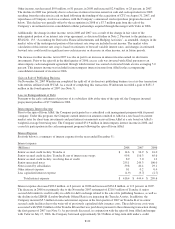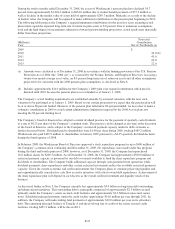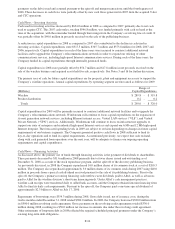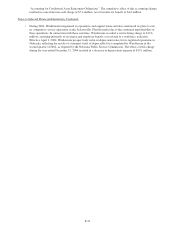Windstream 2008 Annual Report Download - page 118
Download and view the complete annual report
Please find page 118 of the 2008 Windstream annual report below. You can navigate through the pages in the report by either clicking on the pages listed below, or by using the keyword search tool below to find specific information within the annual report.
expect any changes in the effectiveness of its swaps due to counterparty risk or further prepayment of hedged items,
but any such changes could result in a loss of critical terms matching under DIG No. G7 and subsequently an increase
in the ineffective portion of the swaps. An increase in the value of the ineffective portion of its swaps either through
further de-designation of existing swaps or through further decreases in the LIBOR rate could have an adverse impact
on the Company’s future earnings.
See Notes 2, 5 and 6 for additional information on Windstream’s derivative instruments.
Income Taxes – Our estimates of income taxes and the significant items resulting in the recognition of deferred tax
assets and liabilities are disclosed in Note 12 and reflect our assessment of future tax consequences of transactions that
have been reflected in our financial statements or tax returns for each taxing authority in which we operate. Actual
income taxes to be paid could vary from these estimates due to future changes in income tax law or the outcome of
audits completed by federal and state taxing authorities. Included in the calculation of our annual income tax expense
are the effects of changes, if any, to our income tax contingency reserves. We maintain income tax contingency
reserves for potential assessments from the IRS or other taxing authorities. The reserves are determined based upon our
judgment of the probable outcome of the tax contingencies and are adjusted, from time to time, based upon changing
facts and circumstances. Changes to the tax contingency reserves could materially affect our future consolidated
operating results in the period of change. In addition, a valuation allowance is recorded to reduce the carrying amount
of deferred tax assets unless it is more likely than not that such assets will be realized.
Recently Adopted Accounting Pronouncements
Adoption of SFAS No. 162 – In the fourth quarter of 2008, Windstream adopted SFAS No. 162, “The Hierarchy of
Generally Accepted Accounting Principles”. SFAS No. 162 identifies a consistent framework, or hierarchy, for
selecting accounting principles to be used in preparing financial statements for nongovernmental entities that are
presented in conformity with generally accepted accounting principles in the United States. The hierarchical guidance
provided by SFAS No. 162 did not impact the Companies consolidated financial statements.
Adoption of SFAS No. 157 – Effective January 1, 2008, Windstream adopted SFAS No. 157, “Fair Value
Measurements”, for financial assets and liabilities recognized at fair value. SFAS No. 157 defined fair value,
established a framework for measuring fair value and expanded disclosures about the use of fair value to measure
assets and liabilities. Although the adoption of SFAS No. 157 for financial assets and liabilities recognized at fair value
on a recurring basis did not have a material impact on our consolidated financial statements, applying the fair value
measurement framework to non-financial assets and liabilities that are recognized or disclosed at fair value on a
non-recurring basis may have a material impact on future consolidated financial statements.
Adoption of SFAS No. 159 – In the first quarter of 2008, the Company adopted SFAS No. 159, “The Fair Value Option
for Financial Assets and Financial Liabilities – Including an Amendment of Financial Accounting Standards Board
(“FASB”) Statement No. 115”. Since Windstream did not elect the fair value option for any of its eligible financial
assets and liabilities, the adoption of SFAS No. 159 did not impact the Company’s consolidated financial statements.
Adoption of FIN 48 – Windstream adopted FASB Interpretation No. 48, “Accounting for Uncertainty in Income
Taxes” (“FIN 48”) on January 1, 2007. FIN 48 clarifies the accounting for and disclosure of uncertainty in tax positions
and provides guidance on the recognition, measurement, derecognition, classification, and disclosure of tax positions
and on the accounting for related interest and penalties. As a result of the adoption of FIN 48, we recognize accrued
interest and penalties related to unrecognized tax benefits as a component of income tax expense. Although the
adoption of this standard has not had a significant impact on the Company’s tax provision thus far, the recognition of
tax uncertainties through earnings in the future could be materially impacted by this new accounting policy.
Adoption of SFAS No. 158 – As of December 31, 2006, the Company adopted the provisions of SFAS No. 158
“Employers’ Accounting for Defined Benefit Pension and Other Postretirement Plans, an amendment of FASB
Statements No. 87, 88, 106 and 132 (R)”. SFAS No. 158 required the Company to recognize the funded status of its
defined benefit pension and postretirement plans in its consolidated balance sheet as of December 31, 2006. Future
changes in the funded status will be recognized in the year in which the change occurs through other comprehensive
income.
Adoption of SFAS No. 123(R) – On January 1, 2006, the Company adopted SFAS No. 123(R), “Share-Based
Payment”, which is a revision of SFAS No. 123 and supersedes APB Opinion No. 25. SFAS No. 123(R) requires all
share-based payments to employees, including grants of employee stock options, to be valued at fair value on the date
of grant, and to be expensed over the applicable vesting period.
For additional information concerning the adoption of the above mentioned accounting pronouncements see Note 2.
F-30
























